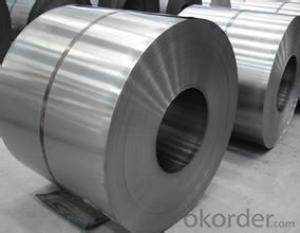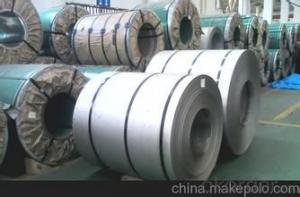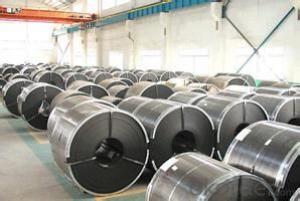excenllent cold rolled steel coil-SPCC-1D in good Quality
- Loading Port:
- China main port
- Payment Terms:
- TT OR LC
- Min Order Qty:
- 30 m.t.
- Supply Capability:
- 5000000 m.t./month
OKorder Service Pledge
OKorder Financial Service
You Might Also Like
Specification
The raw material of cold rolled steel coil/sheet is high quality hot rolled product, and after pickling, kinds of new technology and new process of global cold rolling production have been applied. Therefore the manufacturing, home appliance, automobile etc.
COLD ROLLED STEEL | |
Thicknenss | 0.10mm-4.00mm |
Width | 600mm-2000mm |
Sheets length | 1200-6000mm |
Coil inner diameter | 508-610mm |
Surface treatement | matt finish/bright finish,oiling/dry, bright anneal/black anneal |
Coil weight | 3-5t |
Package & Delivery
Package details: Standardseaworthy packing for international delivery.
Delivery: According to theexact quantity of your order.
Quality of the goods could be guaranteed. The finished product has a variety of excellent capabilities, such as continuous rolling, degreasing, annealing, skin pass, slitting and cut to length line etc. Along with it many rocessing capability and smooth, flat surface. It’s widely used in outdoor and interior decoration, furnishing.
Cold rolled steel is widely used in electronic production,Motorbike,Automobile,Stamping structure;Cold bent Sreel;Saw flake and etc;which is a good substitute for cold Roller and Cold plate in many field.
- Q:How are steel coils used in the production of electrical motors?
- Steel coils are used in the production of electrical motors as they serve as the core component of the motor's electromagnetic system. These coils are wrapped around an iron core, creating an electromagnetic field when electricity flows through them. This electromagnetic field generates the necessary force that allows the motor to convert electrical energy into mechanical energy, enabling the motor to function and perform various tasks.
- Q:Want to construct a patio cover approx. 20 feet long. Only want to use a 6x6 or 8x8 post at each end. What size steel i-beam would I have to use to carry the load???
- consult your local building for the area design loads including, live dead and wind.many local steel supp;iers can design it for you.
- Q:What are the factors influencing the price of steel coils?
- There are several factors that influence the price of steel coils. 1. Raw material costs: The price of steel coils is directly impacted by the cost of raw materials, such as iron ore and coal. Fluctuations in these commodity prices can greatly affect the overall price of steel coils. 2. Demand and supply: The supply and demand dynamics in the steel industry play a significant role in determining the price of steel coils. If there is a high demand for steel products, the price of steel coils is likely to increase. Conversely, if there is an oversupply of steel, prices may decrease. 3. Production and manufacturing costs: The cost of producing and manufacturing steel coils, including labor, energy, and transportation costs, can impact the final price of the product. Any changes in these costs can influence the overall price of steel coils. 4. Currency exchange rates: Steel is a global commodity, and its price can be influenced by fluctuations in currency exchange rates. If the currency in which steel is traded weakens against other currencies, it can result in higher prices for steel coils. 5. Government regulations and policies: Government regulations and policies, such as import tariffs, export restrictions, and environmental regulations, can impact the price of steel coils. These regulations can affect the cost of production and trade, ultimately influencing the price of steel coils. 6. Market competition: The level of competition among steel manufacturers and suppliers can also impact the price of steel coils. If there are multiple suppliers and manufacturers in the market, it can lead to competitive pricing, potentially driving down the price. On the other hand, if the market is dominated by a few suppliers, prices may be higher. It is important to note that these factors can vary over time and in different regions, ultimately affecting the pricing of steel coils in the market.
- Q:How do steel coils contribute to the aerospace industry?
- The aerospace industry benefits greatly from the utilization of steel coils. They serve multiple purposes in this field. Firstly, they are instrumental in the production of aircraft structures and components. Steel coils can be transformed into various forms, such as sheets or plates, which can then be shaped and welded to create essential parts of an aircraft, including wings, fuselage, and landing gear. The exceptional strength and durability of steel make it an optimal material for such critical components, guaranteeing the safety and dependability of the aircraft. Secondly, steel coils play a pivotal role in the manufacturing of jet engines. The extreme conditions and high temperatures that engines endure necessitate materials with outstanding heat resistance and mechanical properties. Steel coils, especially those made from alloys like stainless steel or nickel-based alloys, possess the requisite attributes to withstand the demanding environment within a jet engine. These coils can be processed into turbine blades, exhaust system components, and other engine parts, thereby enhancing the overall performance and efficiency of the aircraft. Furthermore, steel coils find utility in the construction of aerospace infrastructure and ground support equipment. Strong and durable materials are essential for ensuring the stability and longevity of structures like hangars, maintenance facilities, and launch pads. Steel coils are frequently fabricated into beams, columns, and other structural elements that form the foundation of these facilities, providing the necessary strength to withstand the various loads and vibrations associated with aerospace operations. In conclusion, the aerospace industry heavily relies on steel coils due to their indispensable qualities of strength, durability, and heat resistance. These coils contribute significantly to the manufacturing of aircraft structures, engine components, and aerospace infrastructure, thereby guaranteeing the safety, performance, and reliability of aircraft. This, in turn, facilitates the advancement of aviation technology and enables the exploration of new frontiers in aerospace.
- Q:What is the process of pickling and oiling steel coils?
- To ensure the quality and protection of steel coils, a series of steps are undertaken in the process of pickling and oiling. The first step involves pickling, wherein impurities and scale are removed from the surface of the steel coil. This is achieved by immersing the coil in an acid bath, such as hydrochloric acid or sulfuric acid, which effectively dissolves any oxides, rust, or contaminants present on the surface. This step is critical as it readies the steel for further processing and safeguards against potential defects or corrosion. Following pickling, the steel coils are rinsed with water to eliminate any residual acid and then dried. Once they are clean and dry, a layer of oil is applied to provide temporary corrosion protection and lubrication during subsequent handling and transport. The oil coating acts as a barrier, preventing rusting or oxidation before the steel undergoes further processing or is utilized in various applications. The oiling process can be executed through various methods. One common approach is to apply the oil using a roller or brush, ensuring an even coating across the entire surface of the coil. Alternatively, the coils can be passed through a bath or spray chamber where the oil is administered. The choice of oil depends on the specific requirements of the steel and its intended use, with options ranging from mineral oil and synthetic oils to specialized rust-preventive coatings. Once the oiling process is complete, the steel coils are typically stacked, wrapped, or packaged for storage or transportation. It is crucial to handle the coils with care to avoid damaging the oil coating and compromising the corrosion protection it provides. Overall, the pickling and oiling of steel coils are indispensable steps in the steel manufacturing process. They ensure the quality, cleanliness, and protection of the steel, thereby prolonging its lifespan and enhancing its performance in various applications.
- Q:Can steel coils be coated with anti-tampering materials?
- Yes, steel coils can be coated with anti-tampering materials. These materials are commonly applied to steel coils to prevent unauthorized access or tampering, ensuring the integrity and security of the contents within the coils.
- Q:What are the main factors that affect the corrosion resistance of steel coils?
- The main factors that affect the corrosion resistance of steel coils include the composition and purity of the steel, the presence of alloying elements, the surface condition and finish of the coils, the exposure to moisture and corrosive substances, and the protective coatings or treatments applied to the steel.
- Q:How are steel coils inspected for coil set?
- Various methods and equipment are utilized to inspect steel coils for coil set. Coil set refers to the curvature or shape of the coil, which can affect its performance and usability in different applications. One way to inspect steel coils for coil set is through visual examination. Experienced operators or inspectors carefully assess the coils for any visible deformities or irregularities in their shape. This can be accomplished by unrolling a section of the coil and checking for signs of buckling, twisting, or unevenness. Visual inspection is a simple and cost-effective method to identify evident coil set issues. In addition to visual examination, more advanced techniques are employed to accurately measure and quantify coil set. One such technique involves using a straight edge or template. The straight edge is placed along the length or width of the unrolled portion of the coil, and any gaps or deviations from the straight edge indicate the presence of coil set. This method provides a more precise measurement of the extent and severity of the coil set. Another commonly used technique is the utilization of specialized tools like a non-contact laser measurement system. This system projects a line onto the surface of the coil using lasers and measures the distance between the line and the coil. Any variations in this distance indicate the presence of coil set. This method offers high accuracy and provides detailed data on the coil's shape and curvature. Other methods may involve the use of mechanical devices such as rollers or tensioners to unroll and measure the coil's shape. These devices exert controlled pressure on the coil to straighten it out, and any resistance or deviations encountered during the process serve as indications of coil set. Overall, the inspection of steel coils for coil set involves a combination of visual examination and precise measurement techniques. These methods aid in identifying and quantifying any deformities or irregularities in the coil's shape, enabling manufacturers and customers to make informed decisions about the usability and quality of the steel coils.
- Q:How are steel coils straightened?
- Steel coils are straightened using a process called leveling, which involves passing the coil through a series of rollers that apply pressure to gradually remove any bends or deformations in the steel.
- Q:Can steel coils be coated with PVC?
- Yes, steel coils can be coated with PVC.
1. Manufacturer Overview |
|
|---|---|
| Location | |
| Year Established | |
| Annual Output Value | |
| Main Markets | |
| Company Certifications | |
2. Manufacturer Certificates |
|
|---|---|
| a) Certification Name | |
| Range | |
| Reference | |
| Validity Period | |
3. Manufacturer Capability |
|
|---|---|
| a)Trade Capacity | |
| Nearest Port | |
| Export Percentage | |
| No.of Employees in Trade Department | |
| Language Spoken: | |
| b)Factory Information | |
| Factory Size: | |
| No. of Production Lines | |
| Contract Manufacturing | |
| Product Price Range | |
Send your message to us
excenllent cold rolled steel coil-SPCC-1D in good Quality
- Loading Port:
- China main port
- Payment Terms:
- TT OR LC
- Min Order Qty:
- 30 m.t.
- Supply Capability:
- 5000000 m.t./month
OKorder Service Pledge
OKorder Financial Service
Similar products
New products
Hot products
Related keywords






























